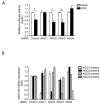The Importance of AGO 1 and 4 in Post-Transcriptional Gene Regulatory Function of tRF5-GluCTC, an Respiratory Syncytial Virus-Induced tRNA-Derived RNA Fragment
- PMID: 33233493
- PMCID: PMC7699471
- DOI: 10.3390/ijms21228766
The Importance of AGO 1 and 4 in Post-Transcriptional Gene Regulatory Function of tRF5-GluCTC, an Respiratory Syncytial Virus-Induced tRNA-Derived RNA Fragment
Abstract
Respiratory syncytial virus (RSV) is the most common cause of lower respiratory tract infection in infants, the elderly, and immune-compromised patients. It is also a significant contributor to upper respiratory tract infection in the pediatric population. However, its disease mechanisms are still largely unknown. We have recently shown that a tRNA-derived RNA fragment (tRF) from the 5'-end of mature tRNA encoding GluCTC (tRF5-GluCTC), a recently discovered non-coding RNA, is functionally important for RSV replication and host gene regulation at the post-transcriptional level. However, how tRF5-GluCTC carries out the gene regulation is not fully known. In this study, we found that tRF5-GluCTC has impaired gene trans-silencing function in cells deficient of AGO1 or 4, while AGO2 and 3 seem not involved in tRF5-GluCTC-mediated gene regulation. By pulling down individual AGO protein, we discovered that tRF5-GluCTC is detectable only in the AGO4 complex, confirming the essential role of AGO4 in gene regulation and also suggesting that AGO1 contributes to the gene trans-silencing activity of tRF5-GluCTC in an atypical way. We also found that the P protein of RSV is associated with both AGO1 and 4 and AGO4 deficiency leads to reduced infectious viral particles. In summary, this study demonstrates the importance of AGO1 and 4 in mediating the gene trans-silencing function of tRF5-GluCTC.
Keywords: RSV; argonaute; post-transcriptional gene regulation; tRNA-derived RNA fragments.
Conflict of interest statement
We declare no conflict of interest.
Figures




Similar articles
-
Role of Poly(A)-Binding Protein Cytoplasmic 1, a tRNA-Derived RNA Fragment-Bound Protein, in Respiratory Syncytial Virus Infection.Pathogens. 2024 Sep 12;13(9):791. doi: 10.3390/pathogens13090791. Pathogens. 2024. PMID: 39338982 Free PMC article.
-
Respiratory Syncytial Virus Utilizes a tRNA Fragment to Suppress Antiviral Responses Through a Novel Targeting Mechanism.Mol Ther. 2015 Oct;23(10):1622-9. doi: 10.1038/mt.2015.124. Epub 2015 Jul 9. Mol Ther. 2015. PMID: 26156244 Free PMC article.
-
Identification of two novel functional tRNA-derived fragments induced in response to respiratory syncytial virus infection.J Gen Virol. 2017 Jul;98(7):1600-1610. doi: 10.1099/jgv.0.000852. Epub 2017 Jul 15. J Gen Virol. 2017. PMID: 28708049 Free PMC article.
-
Non-Coding RNAs and Their Role in Respiratory Syncytial Virus (RSV) and Human Metapneumovirus (hMPV) Infections.Viruses. 2020 Mar 21;12(3):345. doi: 10.3390/v12030345. Viruses. 2020. PMID: 32245206 Free PMC article. Review.
-
Roles of Non-coding RNAs in Respiratory Syncytial Virus (RSV) Infection.Curr Top Microbiol Immunol. 2018;419:215-241. doi: 10.1007/82_2017_32. Curr Top Microbiol Immunol. 2018. PMID: 28646339 Review.
Cited by
-
tRNA-derived small RNAs in human cancers: roles, mechanisms, and clinical application.Mol Cancer. 2024 Apr 15;23(1):76. doi: 10.1186/s12943-024-01992-2. Mol Cancer. 2024. PMID: 38622694 Free PMC article. Review.
-
The Impact of EPAC2-Associated Junction Plakoglobin on Respiratory Syncytial Virus Infection.Viruses. 2025 Apr 26;17(5):627. doi: 10.3390/v17050627. Viruses. 2025. PMID: 40431638 Free PMC article.
-
Computational Analysis Suggests That AsnGTT 3'-tRNA-Derived Fragments Are Potential Biomarkers in Papillary Thyroid Carcinoma.Int J Mol Sci. 2024 Oct 2;25(19):10631. doi: 10.3390/ijms251910631. Int J Mol Sci. 2024. PMID: 39408960 Free PMC article.
-
Identification of tRF-29-79MP9P9NH525 as a biomarker and tumor suppressor of gastric cancer via regulating KIF14/AKT pathway.Cell Death Discov. 2025 May 15;11(1):238. doi: 10.1038/s41420-025-02514-9. Cell Death Discov. 2025. PMID: 40374610 Free PMC article.
-
Transfer RNAs-derived small RNAs and their application potential in multiple diseases.Front Cell Dev Biol. 2022 Aug 22;10:954431. doi: 10.3389/fcell.2022.954431. eCollection 2022. Front Cell Dev Biol. 2022. PMID: 36072340 Free PMC article. Review.
References
-
- Kutsaya A., Teros-Jaakkola T., Kakkola L., Toivonen L., Peltola V., Waris M., Julkunen I. Prospective clinical and serological follow-up in early childhood reveals a high rate of subclinical RSV infection and a relatively high reinfection rate within the first 3 years of life. Epidemiol. Infect. 2016;144:1622–1633. doi: 10.1017/S0950268815003143. - DOI - PMC - PubMed
MeSH terms
Substances
Grants and funding
LinkOut - more resources
Full Text Sources
Molecular Biology Databases

